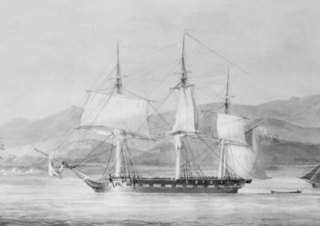
The Gunboat War was a naval conflict between Denmark–Norway and Great Britain supported by Sweden during the Napoleonic Wars. The war's name is derived from the Danish tactic of employing small gunboats against the materially superior Royal Navy. In Scandinavia it is seen as the later stage of the English Wars, whose commencement is accounted as the First Battle of Copenhagen in 1801.

HMS Pomone was a 38-gun Leda-class fifth rate of the Royal Navy launched in 1805. She saw action during the Napoleonic Wars, primarily in the Mediterranean while under the command of Captain Robert Barrie. She was wrecked off The Needles, part of the Isle of Wight, in 1811. The wreck is a Protected Wreck managed by Historic England.
HMS Staunch was a Royal Navy 12-gun Archer-class gun-brig, built by Benjamin Tanner and launched in 1804 at Dartmouth, Devon. She served in the Indian Ocean and participated in the action of 18 September 1810 before she foundered with the loss of all hands in 1811.
HMS Olympia was an Adonis-class schooner of the Royal Navy during the Napoleonic War. She was built at Bermuda using Bermudan cedar and completed in 1806. In March 1811 the French captured her, but the British recaptured her in October. During her career, she served as far afield as Buenos Aires, Île Bourbon, and Cape of Good Hope. The Admiralty sold her in 1815.
HMS Algerine was a Pigmy–class 10-gun schooner of the Royal Navy. She was launched in March 1810. She served in the North Sea and then transferred to the West Indies, where she was wrecked in 1813.

HMS Persian was a Cruizer-class brig-sloop built by Daniel List and launched at Cowes in 1809. She captured two privateers before she wrecked in 1813.
HMS Telegraph was built in 1812 in New York as the American letter of marque Vengeance. The Royal Navy captured her in 1813 and took her into service as the 14-gun schooner or gunbrig Telegraph. Over a period of only about two years she took numerous small prizes and caused the destruction of a French 16-gun brig. A gale caused the wrecking of Telegraph in 1817.

HMS Foxhound was an 18-gun Cruizer-class brig-sloop built by King at Dover and launched in 1806. She participated in the battle of the Basque Roads in early 1809 and foundered later that year.
HMS Whiting was a Royal Navy Ballahoo-class schooner of four 12-pounder carronades and a crew of 20. The prime contractor for the vessel was Goodrich & Co., in Bermuda, and she was launched in 1805. She was a participant at the Battle of Basque Roads. A French privateer captured her at the beginning of the War of 1812, shortly after the Americans had captured and released her in the first naval incident of the war.
His Majesty's hired armed lugger Black Joke was a lugger of ten 12-pounder carronades and 10892⁄94 tons burthen that entered into the service of the Royal Navy on 22 May 1808.
During the period of the Napoleonic Wars, two vessels have served the British Royal Navy as His Majesty's Hired armed cutter Idas, named for Idas, a figure from Greek mythology.
His Majesty's Hired armed lugger Duke of York served the Royal Navy from 14 October 1794 to 2 January 1799 when she foundered in the North Sea.
HMS Nemesis was a 28-gun Enterprise-class sixth-rate frigate of the Royal Navy. The French captured her in 1795 at Smyrna, but in 1796 a squadron led by Barfleur brought her out of the neutral port of Tunis. Throughout her career she served under a number of commanders who would go on to have distinguished careers. She was converted to a troopship in 1812 and was sold in 1814.

HMS Piercer was a Royal Navy Archer-class gun-brig launched in 1804. She served against the French, Danes and Dutch in the Napoleonic Wars and was assigned to the Downs station. She participated in a number of operations in the Bay of Biscay, the English Channel, and the North Sea. In 1814 the British government transferred Piercer to the Kingdom of Hanover for use as a guard ship. Hanover decommissioned her in 1850.
HMS Briseis was a 10-gun Cherokee- class brig-sloop of the Royal Navy, launched in 1808 at Upnor, on the River Medway. She participated in one notable single ship action before she wrecked in 1816.
Two vessels named His Majesty's Hired armed cutter Adrian served the British Royal Navy during the Napoleonic Wars as hired armed vessels.

HMS Monkey was launched in 1801 at Rochester. She served in the Channel, North Sea, and the Baltic, and was wrecked in December 1810.
HMS Growler was a Archer-class gun-brig built for the British Royal Navy and launched in 1804. She captured several French privateers and one Danish privateer, and took part in two actions that earned her crew the Naval General Service Medal (NGSM). She was sold in 1815.

HMS Minerva was a 32-gun fifth-rate Thames-class frigate of the Royal Navy, launched in 1805 at Deptford. Her namesake was the Roman goddess Minerva.
HMS Conflict was launched in 1805. She captured a number of vessels, including privateers, and participated in several major actions. She disappeared in November 1810 with the loss of all her crew.





